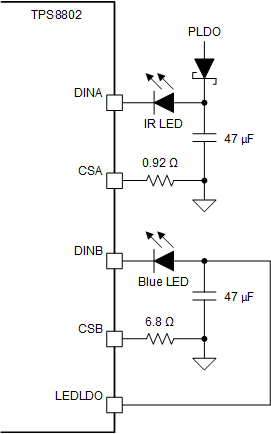SLVAET3 October 2021 TPS8802
- Trademarks
- 1Introduction
- 2System Architecture
- 3Current Consumption
- 4System Power Calculation and Measurements
- 5Summary
- 6References
2.4.2 LED Connected to PLDO
An infrared LED or low current blue LED can be powered through PLDO with a low-leakage Schottky diode. PLDO is supplied by VCC and can supply a voltage higher than VBAT if VCC is connected to VBST. PLDO has two operating modes: a pass-through mode when VCC is less than 5 V (typical), and a regulation mode when VCC is greater than 5 V (typical). The pass-through mode shorts PLDO to VCC. The regulation mode has a minimum 1 V drop between VCC and PLDO. Therefore, PLDO is most efficient when it is operating in the pass-through mode. The Schottky diode must be low-leakage, approximately 0.1 µA, to prevent the LED capacitor from discharging into PLDO when the boost converter is disabled. A silicon diode can be used instead of a Schottky diode if the higher voltage drop is tolerable.
 Figure 2-6 IR LED Connected to PLDO Through a Low-Leakage Schottky Diode
Figure 2-6 IR LED Connected to PLDO Through a Low-Leakage Schottky Diode